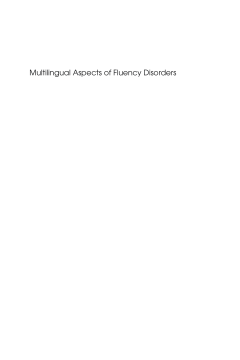
Additional Information
Book Details
Abstract
This book contains contributions by scholars working on diverse aspects of speech who bring their findings to bear on the practical issue of how to treat stuttering in different language groups and in multilingual speakers. The book considers classic issues in speech production research, as well as whether regions of the brain that are affected in people who stutter relate to areas used intensively in fluent bilingual speech. It then reviews how formal language properties and differential use of parts of language affect stuttering in English, and then compares these findings to work on stuttering in a variety of languages. Finally, the book addresses methodological issues to do with studies on bilingualism and stuttering; and discusses which approach is appropriate in the treatment of bilingual and multilingual people who stutter.
Peter Howell is an experimental psychologist and co-director of the Centre for Human Communications at University College London. His research interests are in speech production and perception and hearing.
John Van Borsel is a neurolinguist teaching at the Ghent University (Belgium) and at the Veiga Almeida University in Rio de Janeiro (Brazil). Fluency disorders are one of his main research domains.
This book provides useful information about the infrequently discussed issue of bilingualism as it relates to the possible onset of stuttering. With the dramatically changing demographics in the United States, this collection of papers provides both the researcher and clinician with current views for understanding both basic and clinical implications for the various forms of bilingualism and fluency characteristics.
Walt Manning, Ph.D., Professor & Associate Dean, School of Audiology and Speech-Language Pathology, The University of Memphis
Comprehensive, clear coverage of the complex topic of bilingualism and stuttering. Approaching this topic from a language perspective, all things are considered from genetic, cortical, and environment to cultural, clinical, even animistic factors! A must-have reference for clinicians and researchers alike!!
Table of Contents
| Section Title | Page | Action | Price |
|---|---|---|---|
| Contents | v | ||
| Contributors | vii | ||
| Preface | ix | ||
| Part 1: Procedures, Methods and Findings for Language and Its Disorders | 1 | ||
| 1 The Speech of Fluent Child Bilinguals | 3 | ||
| 2 Speech Production in Simultaneous and Sequential Bilinguals | 24 | ||
| 3 Genetics and Language | 43 | ||
| 4 Brain Structure and Function in Developmental Stuttering and Bilingualism | 63 | ||
| Part 2: Monolingual Language Diversity and Stuttering | 91 | ||
| 5 The Speech and Language Characteristics of Developmental Stuttering in English Speakers | 93 | ||
| 6 Stuttering in Japanese | 139 | ||
| 7 Disfluent Speech Characteristics of Monolingual Spanish-Speaking Children | 169 | ||
| 8 Characteristics of Developmental Stuttering in Iran | 192 | ||
| 9 Stuttering Research in Brazil: An Overview | 214 | ||
| 10 A Survey on Traditional Treatment Practices for Stuttering in Sub-Saharan Africa | 232 | ||
| Part 3: Bilingual Language Diversity, Stuttering and Its Treatment | 245 | ||
| 11 Review of Research on the Relationship between Bilingualism and Stuttering | 247 | ||
| 12 Stuttering in English-Mandarin Bilinguals in Singapore | 271 | ||
| 13 Linguistic Analysis of Stuttering in Bilinguals: Methodological Challenges and Solutions | 308 | ||
| 14 Treating Bilingual Stuttering in Early Childhood: Clinical Updates and Applications | 332 | ||
| 15 Methodology Matters | 353 | ||
| Part 4: Conclusions | 371 | ||
| 16 Fluency Disorders and Language Diversity: Lessons Learned and Future Directions | 373 | ||
| Index | 386 |
